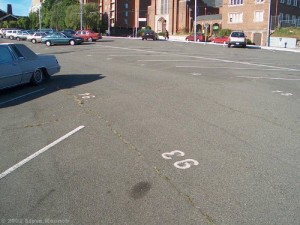Block Cracking
Interconnected cracks that divide the pavement up into rectangular pieces. Blocks range in size from approximately 1 ft2 to 100 ft2. Larger blocks are generally classified as longitudinal and transverse cracking. Block cracking normally occurs over a large portion of pavement area but sometimes will occur only in non-traffic areas.

Block cracking in a parking lot near the University of Washington. Block cracking in parking lots is common because many parking lot pavements experience only light traffic (e.g., no heavy trucks).
Problem
Allows moisture infiltration, roughness
Possible Causes
HMA shrinkage and daily temperature cycling. Typically caused by an inability of asphalt binder to expand and contract with temperature cycles because of:
- Asphalt binder aging
- Poor choice of asphalt binder in the mix design
Repair
Strategies depend upon the severity and extent of the block cracking:
- Low severity cracks (< 1/2 inch wide). Crack seal to prevent (1) entry of moisture into the subgrade through the cracks and (2) further raveling of the crack edges. HMA can provide years of satisfactory service after developing small cracks if they are kept sealed (Roberts et. al., 1996).
- High severity cracks (> 1/2 inch wide and cracks with raveled edges). Remove and replace the cracked pavement layer with an overlay.
Surface Distresses



